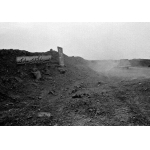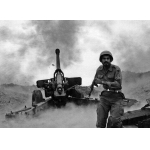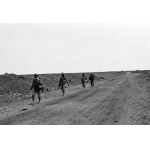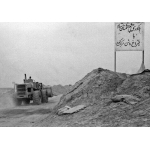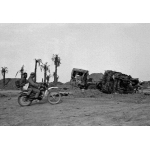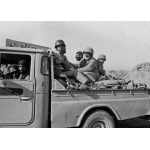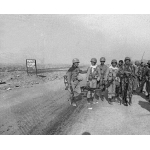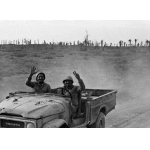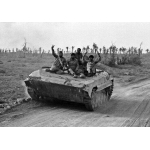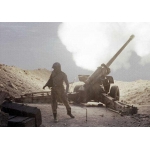Operation Karbala-8
Nahid Khodi
345 بازدید
Operation Karbala-8 was carried out on April 8, 1987. It was conducted with the aim of destroying the Iraqi forces located within the operational area and consolidating the positions gained in Operation Karbala-5. However, after five days, in the operational area east of Basra, the ground forces of the Islamic Revolutionary Guard Corps did not reach the designed target, despite the losses dealt to the Iraqi military.
After Operation Karbala-5, the situation on the front lines of Iran and Iraq demanded the continuation of operations in that area. Advancing from Nahr Doaiji towards the Jassim Line, trying to break this line, continuing the operation towards the Zoji Channel and forming a defense line there, were considered to be the most important goals of Operation Karbala-5. Therefore, operations were carried out in these areas in two stages. The first stage, which lasted until March 3, 1987, and was a preparatory operation to Operation Karbala-5, did not yield great success due to the vigilance of the Iraqi army and the complexity of the terrain. The second stage, operation Karbala-8, was designed and executed 36 days after the preparatory operation.
Initially, the IRGC planned to gradually improve and complete the lines of the captured area with a few limited operations and by reaching the Jovi Channel. However, due to the obstacles that existed there, Operation Karbala-8 was designed and planned to be implemented in two axes by two bases.[1]
On April 8, 1987, two IRGC bases, namely, Karbala and Quds, in the same operational area of Operation Karbala-5, i.e., Shalamcheh, with the use of 7 divisions and combat brigades, and with the codename of “Ya Sahib al-Zaman”, started an operation attempting to seize the Zoji Channel, east of Basra. Nevertheless, the Iraqi army was aware of this operation and as soon as it began, it placed all the front lines under the fire of its various weapons. A fierce battle broke out, with fifty Iraqi tanks and vehicles being destroyed and a total of about two hundred Iraqi soldiers being captured.
In the continuation of this operation, the 33rd al-Mahdi Brigade, 27th Muhammad Rasulullah Brigade, 17th Ali Ibn Abi Talib Brigade, 25th Karbala Brigade, 19th Fajr Brigade, 10th Sayyid al-Shuhadah Brigade, 8th Najaf Brigade, and the 31st Ashura Brigade went into action. However, a total of two square kilometers of land west of the Zojj Channel was captured and about 2000 Iraqi soldiers were killed and wounded. Two Iraqi planes also crashed, while 300 Iranian soldiers were also martyred.
Operation Karbala-8 was implemented in three stages and lasted five days; But it did not reach the intended goals and was unsuccessful. During this operation, on April 9 and 10, 1987, the Iraqi army also used chemical weapons and mustard gas, which resulted in approximately two hundred Iranians being injured. Also, at midnight on April 11, 1987, the Iraqi army attacked Khorramshahr and Shalamcheh with nerve gas and a small amount of mustard gas, which resulted in a large number of martyrs and about three hundred people getting injured. In this area, the Iraqi army threw sarin gas at the Iranians for the first time, alongside Katyusha rockets and then attacked Patek.
The IRGC units retreated from the captured positions on April 12, 1987, following the repeated raids of the Iraqi army. The headquarters of Khatam al-Anbiyah claimed that one of the reasons for this operation was to respond to the evils committed by Iraq in attacking Iran's economic resources and disrupting the security of shipping in the Persian Gulf. During this operation, the Iraqi army also chemically attacked the Khorramshahr Water Treatment Center, martyring and injuring most of its workers.[2]
Iraq's use of chemical weapons caused many injuries to Iranian forces. From 1983 to the end of the war, Iraq's production and use of chemical weapons increased considerably. Most of these attacks took place during Operations Karbala-5 and Karbala-8, in the eastern region of Basra.
Iraq's pressure in trying to recapture an area of about one square kilometer was unique in its kind. Understanding the new military policy of the Islamic Republic of advancing in the east of Basra and the successive destruction of the Iraqi forces, the enemy decided to discourage the planners and officials of the war within the Islamic Republic from continuing to advance in the east of Basra with a firm and strong response.[3]
Agence France-Presse reported: "The objectives of Iran's new Operation Karbala-8, which is purely military, seem limited. Iran, without a doubt, has chosen this southern part to attack in order to prevent the enemy's lines from consolidating there."
In fact, the report of the French news agency focused on the fact that this operation contained a message regarding the continuation of Iran's series of efforts in this region and plan to carry out operations towards Basra.[4]
The coincidence of Operation Karbala-8 being aligning with the 48th anniversary celebrations for the founding of the Baath party caused Iraq to immediately attack and cause significant damage to the oil facilities on the Siri Island, which was one of the sources of Iran's oil exports. It was damaged to such an extent that it was out of service for some time.[5]
[1]Ardestani, H., Punishment of the aggressor, Tehran: Islamic Revolutionary Guard Corps, Holy Defense Documentation and Research Center, 2000, pp. 288 and 289.
[2] Alaei, H., Iran-Iraq War Process, Volume 2, Tehran: Merz and Bom, 2011, p. 335.
[3]Drodian, M., The Process of Ending the War, Tehran: Islamic Revolutionary Guard Corps, Holy Defense Documentation and Research Center, 2004, p. 168.
[4] Ardestani, H., Punishment of the transgressor, pp. 299 and 300.
[5] Drodian, M., A Review of the Iran-Iraq War, Volume 3: Faw to Shalamcheh, Tehran: Islamic Revolutionary Guard Corps, Holy Defense Documents and Research Center, 2nd quarter, 1999, pp. 172 and 173.



